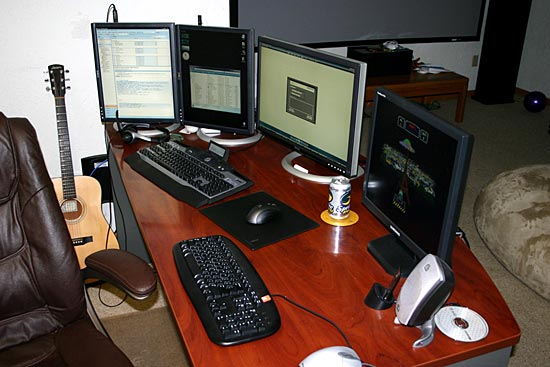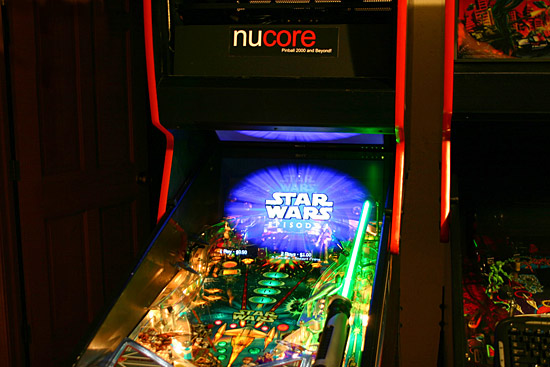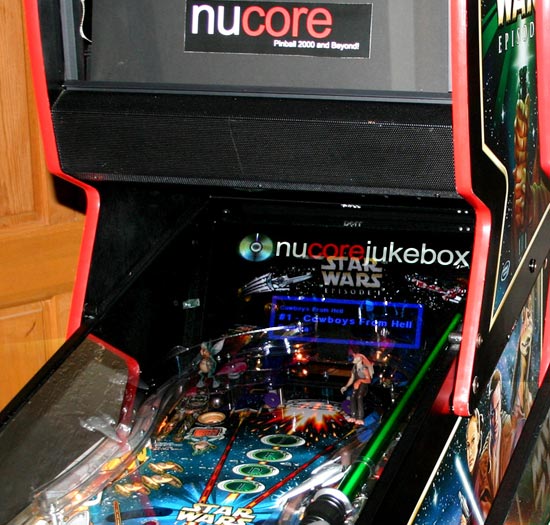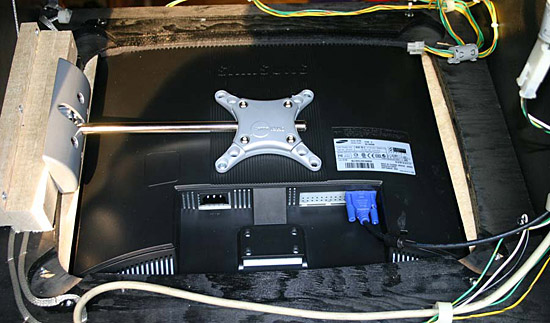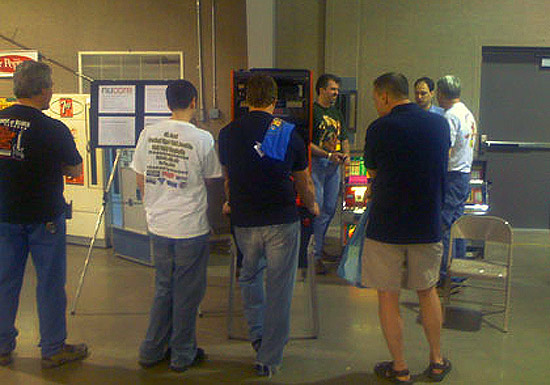|
|
| Date: 28th May 2008. Love it or loathe it, Pinball 2000 made a big impact when it was launched in January 1999 and despite not seeing the year out, over 10,000 units were sold, the vast majority of which still survive today. But while Pinball 2000 used many common parts of the kind technicians would already have in stock, it had an Achilles Heel which prevented - and still prevents - many potential owners buying one - the computer system that drives it. Because it had a very specialised task to perform, a specific motherboard was chosen which included a Cyrix MediaGX processor, running a custom operating system with the audio processing and game code on another custom board - the PRISM card. The motherboard and processor were commercial products, but like most computer hardware from the late '90s it is now obsolete, while the PRISM card was a unique part made purely for Pinball 2000 machines. Consequently, it is highly prized and, when you can find one, it sells for many hundreds of dollars. Although nearly all the remaining parts are available either NOS or as licensed reproductions, the computer has remained the stumbling block for several years. But back in 2004, work began to do something about that by emulating Pinball 2000 on a regular PC and now that work that is about to come to fruition with the launch of the Nucore system by Big Guys Pinball.
Big Guys Pinball is a company set up by Steve Ellenoff, Chuck Hess, and Don Weingarden who have been working together to free Pinball 2000 from the shackles of the dedicated hardware. Steve's pinball memories go back to the early '90s when, during a break from final exams at college, he stumbled upon a Terminator 2 and a Funhouse in the campus rec-room. The T2 appealed to him as a huge fan of the movie but eventually it was the Funhouse that hooked him and kept him pumping the quarters into the slot over the following years. It also led him to combine his computing skills with his pinball interests to emulate many different pinball systems including Williams systems 3-9 as well as those from Data East, Sega, Stern and Capcom for the PinMAME project. Tackling Pinball 2000 though was the biggest challenge of them all, what he describes as "the Mt. Everest of pinball emulation". But Steve's original intentions were not to find a way around the inherent computer issues. "I didn't first sit down and try to solve the Pinball 2000 hardware problem. I just wanted to emulate the machine for the challenge of it and for the pure curiosity of trying to discover how it worked", he said. So he began working on the emulation in August of 2004, continuing through the winter months until by April 2005 he had a something to show for his efforts. "The first version with nearly complete graphics and which booted to attract mode was done by the end of April. There were tons of issues still lurking so I took a year off from the project. I rewrote the entire project starting in July 2006 and had a nearly perfect working emulator by August 2006 (within a few days of when I first started two years previously). The emulator worked great on a PC, but it wasn't fast enough to drive a real Pinball 2000 machine so I stopped work again for a lengthy break." But that break came to an end in early 2007 when he was contacted by Chuck and Don. Chuck and Don first met back in 1983 while Chuck was 16 and working as a technician in a computer store and he sold a computer to Don's father. In the golden age of video games, the two wrote a number of titles before moving towards pinball. Don says he wanted a pinball machine from the age of 12 but his father didn't and Don couldn't afford one by himself. He enjoyed taking electronic appliances apart to fix them but his thirst to work on a pinball remained unquenched until just over four years ago when a he acquired an EM game, followed soon after by a Roadshow and Terminator 2 which he got with Chuck's help. Those games helped him hone his restoration skills and build his collection. Chuck also began playing pinball from a young age, making trips to his local arcade to play Twilight Zone, Funhouse and other favourites. Five years ago he had the opportunity to purchase his first game and like many collectors, his first game was the one he remembered playing in his youth - a Twilight Zone. He too became a collector and a restorer with a basement full of games and regular projects on the go. He told us, "Pinball machines are like Lay's potato chips, you can't have just one. I have around twenty pinball machines and video games in my basement at any given time. I really love restoring machines. I usually pick a project every winter and do a ground-up restoration." Both Don and Chuck bought Revenge from Mars machines and they discovered their love of Pinball 2000 but were both worried about the PRISM card or motherboard failing. Chuck recalls the moment the idea for Nucore really formed for him and Don. "The first time I opened the computer in the RFM I noticed that it was really just a PC with a custom card (PRISM). Don and I knew we could get the software running on a standard PC and knew that the PRISM card would either have to be replicated with new custom hardware or emulated." "Everything seems easy when you first look at it", he grinned. Don, meanwhile had an eye on future possibilities for emulation. "We heard about Wizard Blocks and thought that if Pinball 2000 could be saved, then someday someone would finish Wizard Blocks." In order to create an emulation they knew they needed additional skills but their initial search for help through newsgroups came up empty. It wasn't until they saw a posting by Steve in the Visual Pinball forums that the three of them hooked up in early 2007 to work together on what is now Nucore.
With the team assembled, recreating the hardware's functions in software could begin in earnest. They all owned Pinball 2000 machines so could experiment to find out how different aspects of the machine worked, sometimes with unexpected results. Chuck recalls, "If you insert a PRISM board into a standard PC it comes up as a graphics card. I believe they did this since a VGA card is one of the first systems initialized in a PC during the boot process." The first step was for Don and Chuck to go over the code and decide what was needed
Chuck, meanwhile, started basic optimisation of the graphics routines to squeeze out every little performance gain he could get. After two months of coding they were able to play their first game. Chuck recalls, "The first game was really rough but I shot a video shortly after and you can actually see it on our site. After we accomplished that goal we had to improve performance drastically." So he got to work doing just that. "I had the task of optimizing the code. I focused on all of the graphics routines. Since Pinball 2000 is so graphically intensive the performance of these routines was crucial. We also took advantage of multi-core processing by splitting processor intensive tasks so they could run on another core. It's like having two computers running the same code. It gives a big performance boost and reduces bottlenecks." After three months of writing code, the performance had increased beyond that of the original Pinball 2000 system giving the possibility of better screen rendering, smoother animations and additional features.
"The original goal of the project was to create a working replacement for the original Pinball 2000 computer", said Chuck. "Once we achieved that goal we started looking at ways to improve the original platform. Some improvements came out of a desire to improve the performance of the code. The fact that the animation never stops during game play wasn't planned. It came from the fact that graphics pipeline was re-written and not attached to the original code. We also increased the overall frame rate which makes animation smoother." One extra feature is a built-in jukebox which can play MP3 tracks during attract mode and display a slide show of images on the game's monitor. When the start button is pressed, the jukebox shuts down and the game starts as normal.
Another new inclusion is designed to make life easier you want to swap the playfield for a different Pinball 2000 game. Automatic playfield detection removes the need to change game code since the operating system senses which playfield is attached and runs the appropriate game software from its internal storage. Chuck said there are other features planned including extended network support, although these probably won't be available until after launch. "Our main goal now is to get
what we have working perfectly and add improvements later. One of the nice Now you can see Nucore running a Star Wars Episode 1 machine. Just click on the video clip below to watch. Get the Flash Player to see this video clip.
Got problems seeing the video? Consult our help page for assistance.
There is still the need for some additional hardware to reproduce features of the original Pinball 2000 system which can't be performed in software such as audio amplification and driving the built in CRT monitor. Chuck described where the team is now. "Currently Steve and I are finishing the software. We have a few
things to tweak and need to add the Nucore menu system. Don is starting to
implement our final hardware specifications. We want to keep the hardware
as simple as possible which will also make it less expensive and more They expect the software to be completed first with the hardware following soon afterwards so that the complete package could be on the market at the end of the year or in early 2009 if all goes to plan. The intention is to sell two packages - the first will be a complete drop-in replacement for the existing Pinball 2000 computer with all the correct connections ready to go, only requiring the original game ROMs. The second will include the custom hardware and Nucore software but these can then be installed in a PC of the buyer's choice. If you wanted to go the home build route, you would need a PC with a dual core processor although these are common, even at the bottom end of the market. In addition you would need a modestly capable graphics card, 2GB of RAM and a mass storage device such as a hard drive. Chuck told us he spent nearly a month testing different devices such as optical and flash drives and concluded "...when you look at You would also have to fit the PC in the limited space inside a Pinball 2000 head so Big Guys Pinball are working on a computer case with the correct dimensions and mounting points. In order to keep up with the speed of the inputs and outputs, Nucore software runs on a custom distribution of Linux which is supplied and then installed on the PC. You can then add an audio amplifier of your choice, either the replacement one offered with Nucore or perhaps something a little more powerful. While you're pulling the game apart, you could also replace the largest single component in the game - the monitor. Pinball 2000 uses a cathode ray tube (CRT) monitor which can produce some beautifully bright and crisp images but it does have some weaknesses. Firstly, the CRT is a weighty device, contributing significantly to the overall mass of the head. Secondly, it requires high voltages to deflect the electron beams which in turn require special driver circuitry. Finally, the monitors have a tendency to lose their contrast over time while the focus and colour balance can also drift. Just as computer monitors have evolved from CRT to flat panels, so the Pinball 2000 monitor can be replaced with an LCD screen. The guys have tried this and Chuck told us about his experiences. "The quality of an LCD monitor in a Pinball 2000 machine is simply amazing. The colors are extremely vibrant and the contrast is excellent. I also wrote an anti-aliasing/interpolation routine which will provide better graphics quality for users who install LCD monitors."
The mounting hardware is designed for a CRT monitor but there will be guidance on the Nucore website for those who want to make the leap to LCD. Chuck said, "The good news is I figured out a very simple way to mount it after much trial and error. I used a standard VESA TV mount and a few wood blocks. I'm sure other people will figure out better ways to mount them. We will offer a how-to section on our forums just for this purpose." Big Guys Pinball took their Nucore system to the recent Pinball At The Zoo show in Kalamazoo, Michigan to gauge the reaction from the pinball community. The result, Chuck said was "Incredible. I had assumed people would be interested but was very surprised at the enthusiasm it received. People were really blown away. A number came back to see it multiple times. We even had a few people say they knew about the project and really had no plans to buy one until they actually played it and were blown away. The jukebox mode was a definite hit."
With Nucore offering a means to keep existing Revenge From Mars and Star Wars Episode 1 machines alive, it also raises the possibility of building more Pinball 2000 machines using existing or new titles. There were several Pinball 2000 games in development when Williams pulled the plug on the project and their whole pinball division. Much has been discussed about whether the next game - Wizard Blocks, designed by Pat Lawlor - could ever be released. The software certainly isn't finished and this, combined with the lack of available computer systems doomed the project to a fanciful wish. Now though, with the computer supply problems eliminated and expanded knowledge about how Pinball 2000 works, the possibility of Wizard Blocks and other games being developed has received a boost. Chuck said this potential has not been overlooked. "Nucore really is a simple solution to the complex problem of
developing any new Pinball 2000 titles. We are very eager to help in any
way we can to see new games introduced to the platform. Gene Cunningham was
very impressed by Nucore and has approached Big Guys Pinball to talk about a
number of projects. It's far too early to discuss any details but we are One potential stumbling block was the plethora of patents and trademarks attached to the Pinball 2000 system, owned by Williams and licensed to other companies. There have been attempts to stop the Nucore project but despite those, Big Guys Pinball have told Williams of their plans and the news so far is good, as Chuck explained. "We have received a dozen or so emails but have never received any official legal documents. We decided it would be wise to contact Williams and let them know what we were trying to do. Williams asked us to send a document outlining the Nucore system. We sent the document which outlined our plans for their review. We also asked Williams if they had any problems with our plans for Nucore. They reviewed the document and had no issues." All of which bodes well for the future of Nucore and Pinball 2000 in general. Pinball News will keep you updated as Nucore approaches completion and the possibility of developing new features - or even new Pinball 2000 games - progresses.
|



